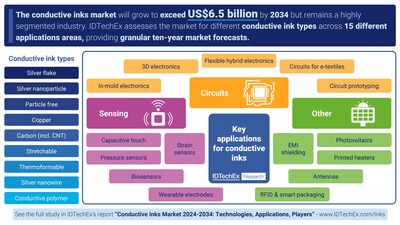IDTechEx Discusses Segmenting the Conductive Inks Market by Formulation and Application
Comunicato Precedente

Comunicato Successivo

Conductive inks are a platform technology that facilitate a very broad range of applications, spanning from the established (photovoltaics) to the emerging (smart packaging). As printed/flexible/hybrid electronics gain traction, opportunities will be created for differentiated conductive inks to meet the needs of emerging applications such as in-mold electronics and wearable technologies. There are many different types of conductive ink, each spanning a different range of parameters, including conductivity, printing yield, and curing time. In this article, IDTechEx gives an overview of some considerations taken when assessing ink technologies and key application areas.
Ink technology
The conductive ink technologies in IDTechEx's report are segmented into the major categories used to market the inks while minimizing duplication where possible. Flake-based silver is today's dominant conductive ink material, estimated to comprise around 97% of the market by weight. It is primarily produced in substantial volumes by large companies such as Henkel, DuPont, and Sun Chemical. Therefore, while it is arguably not an 'emerging technology' itself, the emergence of high-volume applications for printed/flexible electronics, such as smart packaging or electronic skin patches, is expected to drive an increase in sales. Nanoparticle-based inks are generally produced by smaller suppliers, with the key selling point being higher conductivity. However, substantial displacement of conventional flake-based inks for most applications is yet to be seen. Particle-free conductive inks are produced by a range of early-stage companies and offer distinct benefits for electromagnetic interference (EMI) shielding and printed antennas.
Moving beyond silver, copper inks have long been desirable due to the far lower raw material price, and after years of unsuccessfully battling the challenges of oxidation during sintering, they are finally gaining some commercial traction. Carbon-based inks fall into two categories: those based on low-cost commoditized carbon (typically carbon black) and those based on more expensive conductive/semi-conducting nanocarbons such as graphene and carbon nanotubes (CNTs). Stretchable and/or thermoformable conductive inks can be produced using multiple formulations, with flake-based inks with an elastomeric binder the most common. This class of conductive inks is likely to grow rapidly with the adoption of wearable electronics/e-textiles and in-mold electronics (IME). Moving further down the list of ink types also includes silver nanowires and conductive polymers – both suited to particular applications.
Key applications
Conductive inks are arguably the premier platform technology for printed/flexible electronics, utilized in all types of devices and components. As such, these materials have a large and diverse application space, ranging from photovoltaic panels to electronic skin patches and from transparent antennas to pressure sensors. IDTechEx aims to bring structure to this complex application space by segmenting the market into three distinct categories. Circuit manufacturing accounts for conductive inks being used to connect components, with the required properties determined by the manufacturing methodology rather than the device's functionality. Conductive inks may also be used to enable a specific type of sensing, which determines the required properties. Furthermore, conductive inks are used to provide non-sensing functionality beyond simply connecting components.
The current status of the conductive ink market is dominated by the use of silver flake-based ink as a charge collector in photovoltaics. However, an increase in efficiency and transition to the next iteration of solar cell technology will lead to an extremely modest growth in demand for silver flake-based ink in photovoltaics over the coming decade. Indeed, the vast majority of the growth in demand for this dominant ink type will come from emerging opportunities in applications such as 3D electronics, printed heaters, RFID, and smart packaging.
The largest growth opportunity for conductive inks will be in non-silver inks, with market revenue forecast to grow with a CAGR of 24% by IDTechEx. Stretchable/thermoformable inks and copper inks will seize the largest share of this expanding market, driven by applications such as in-mold electronics and wearable electronics. As for silver flake-based inks, RFID and smart packaging is also set to be a key application area when assessing growth over the next ten years.
For more details on the conductive inks market, including segmentations by application area, see the new IDTechEx report, "Conductive Inks Market 2024-2034: Technologies, Applications, Players". To find out more, including downloadable sample pages, please see www.IDTechEx.com/Ink.
For the full portfolio of printed and flexible electronics market research from IDTechEx, please visit www.IDTechEx.com/Research/PE.
Upcoming free-to-attend webinar
IDTechEx Discusses the Key Emerging Applications for Conductive Inks

Dr Conor O'Brien, Senior Technology Analyst at IDTechEx and author of this article, will be presenting a free-to-attend webinar on the topic on Wednesday 3 July 2024 - IDTechEx Discusses the Key Emerging Applications for Conductive Inks.
This webinar will tackle the important question of which applications will drive the conductive inks market, taking into consideration both the volume and value of the required inks for each application. It will include:
Please click here to check timings and register for your specific time zone.
If you are unable to make the date, please register anyway to receive the links to the on-demand recording (available for a limited time) and webinar slides as soon as they are available.
About IDTechEx:
IDTechEx provides trusted independent research on emerging technologies and their markets. Since 1999, we have been helping our clients to understand new technologies, their supply chains, market requirements, opportunities and forecasts. For more information, contact [email protected] or visit www.IDTechEx.com.
Images download:
https://www.dropbox.com/scl/fo/f0d7b9hge9ugcuodizs0e/AAbdchtjtuy2iCINc9jIFQg?rlkey=o101rusyled2wfmtxlpgvs6rg&st=1vkkvqdc&dl=0
Media Contact:
Lucy Rogers
Sales and Marketing Administrator
[email protected]
+44(0)1223 812300
Social Media Links:
Twitter: www.twitter.com/IDTechEx
LinkedIn: www.linkedin.com/company/IDTechEx
![]() View original content:https://www.prnewswire.co.uk/news-releases/idtechex-discusses-segmenting-the-conductive-inks-market-by-formulation-and-application-302167024.html
View original content:https://www.prnewswire.co.uk/news-releases/idtechex-discusses-segmenting-the-conductive-inks-market-by-formulation-and-application-302167024.html





